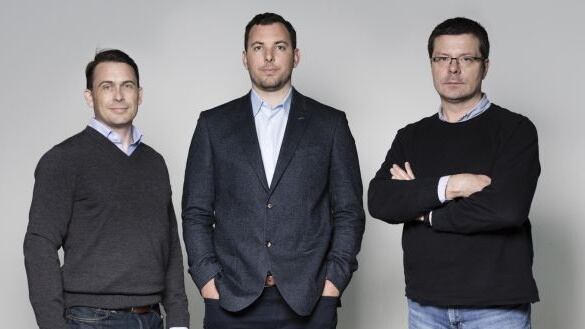Automating cyber risk assessment
Founded in 2014, Cyber Risk International was immediately successful in providing cyber security consultancy services to customers but quickly ran into a near insurmountable barrier to growth.
"I set up Cyber Risk International to assist organisations understand, mitigate and manage cyber risk," says chief executive Paul C Dwyer. "It was successful straight away, and quickly achieved annual sales of over €1 million."
0 of 3
But that was its outer limit. "We hit a glass wall because we couldn't hire the right people," says Dwyer. "We needed highly experienced people who understood not just cyber security and ICT but business as well. We were competing against the likes of Google and Facebook and just couldn't get them. We were struggling to grow. I thought, if we had a piece of software that could fast track what we do we could get through that wall."
The idea was to automate the services provided by Cyber Risk International.
“We build cyber frameworks for companies and you have to understand geopolitical, technical and other risks to do this,” says Dwyer. “We looked around for software that could do it but there was nothing out there. That was when I decided to create a piece of technology to do it. I complied a wish list of what it should do and then set about building it.”
The result was CyberPrism, a highly innovative online solution that combines artificial intelligence (AI) with business and cyber intelligence in order to assess the cyber security, risk and privacy management status of an organisation. In essence it produces a cyber risk rating score, not unlike a credit rating, and offers evidence that an organisation is safe to deal with from a cyber security and privacy perspective.
Development of the solution took place in parallel with the consultancy business. “In 2016 we went into a holding pattern with the company and only took on enough business to fund the development of the product,” says Dwyer.
“We launched the finished product at the Cyber Threat Summit 2018, and we left there with €1 million in orders. In effect, we had morphed into a technology firm from being an advisory business.”
The software takes the place of a consultant, says Dwyer. “We produced an algorithm that incorporates AI and it acts like a consultant. Organisations don’t need consultants if they use CyberPrism – they can do it themselves. The answers lie within the organisation.
“All I did as a consultant was get answers from client companies. The solution incorporates a lot of clever stuff, and has numerous unique selling points. It creates a cyber risk metric for an organisation, and the user doesn’t have to understand about cyber risks, the AI does that.”
It asks the same questions a consultant would and generates a score based on the answers received.
“For example, are you working in the UK or the Ukraine? What sector are you in? What about your employees? These are all risk factors, and the software looks at what they mean for the organisation. We received an award for our methodology from Institute for Risk Management.”
The company is in the process of closing an investment round with Enterprise Ireland.
"The funding round will raise in excess of €700,000. Enterprise Ireland has been nothing short of fantastic. They have helped us get to the position where investors are chomping at the bit. Already people asked to buy into the company three times this year."
Development will continue. “Organisations still face challenges when it comes to interpreting reports. If you are a non-cyber security person and are head of procurement you need to deal with cyber reports on suppliers. The interconnected nature of the supply chain means organisations are assuming responsibility for their suppliers’ security.
“If a supplier produces a report from a cyber security consultant what does that mean? We are working on bringing in natural language processing to present our reports in clear language for easy interpretation. Users won’t have to interpret jargon or be cyber security experts to understand them. We are talking to a few companies about this at the moment. We are not going to try to reinvent the wheel.”
And business is already very good. "Sales will top €1 million this year," says Dwyer. "We have five people working for us now and will make 15 hires in the next 12 months, mainly in sales, marketing and technical roles. CyberPrism has been approved by the UK government, but we are concentrating on North America at the moment because of the Brexit uncertainty."
Keeping pace with the new kids on the banking block
Mainstream banks facing difficulties in competing with the foreign exchange offerings of new entrants like N26 and Revolut now have an answer thanks to a new solution from Irish fintech firm Cambrist. The Cambrist solution enables banks to offer new and innovative foreign exchange solutions to customers without the need for an expensive replacement of the legacy systems which have been holding them back until now.
"Our product is an add-on to the existing transaction processing environment and does not require the installation of new software into the bank's processing environment," says Cambrist chief commercial officer Ross Leonard.
“It’s not just about technology. It’s about new opportunities to develop services. The traditional banks are unable to meet the changing needs of their customers in foreign exchange and those customers are turning to new market entrants like N26, Revolut and Monzo. Between them,they have over 10 million customers, while Revolut now has around 300,000 customers in Ireland.
“These new entrants don’t just threaten the banks in foreign exchange, they are also moving into more traditional banking products.”
The product incorporates a number of modules. The first is a multi-currency payments module.
“This enables the bank to take control and set the foreign exchange rates its customers are paying,” says Leonard. “The payments world is very complex and at present a cardholder either accepts a rate offered by the merchant or the rate which applies when the transaction goes through several days later. Our technology enables the bank to set the rate at the time of transaction in a transparent way that improves service to customers.”
The other modules enable the banks to bring these rates into their existing systems and manage the risks associated with rate setting. “There is an analytics engine to help manage the financial risks,” says Leonard.
This deals with the situation where a bank sets a rate today for a transaction which is only going to be cleared in a number of days’ time. That creates a risk as the market could move in that time. “The analytics engine helps manage risks such as that, ”says Leonard.
“Overall the system enables banks to offer new and differentiated products. Most product teams in banks haven’t had to look at foreign exchange for a very long time. The only thing the card teams thought about was making customers understand that the exchange rate offered by them is better than the merchant offer. The advent of these new entrants is changing that and foreign exchange is becoming part of the competitive mix.”
The initial idea for the solution arose as a result of the direct experience of the company founders, according to Leonard. “They all worked on the initial development of multi-currency products on pre-paid payment cards. They saw that all this capability was available in pre-paid cards but not on the cards in your wallet. They thought that was odd and shouldn’t be that way. They asked why can’t banks do it for their customers.”
The answer was that it was a little bit complicated and not really a focus area for the banks.
“Now the growing presence of Revolut and other services has created a point of pressure around it. Another driver is regulation. The regulators have started to look at it, and there is another piece of regulation coming down the tracks to address transparency in foreign exchange. These three factors combined to create good opportunity to provide something new and innovative in the space. Simply put, the founders worked in the area, and created a product they saw wasn’t yet available.”
Market reaction to the solution has been very positive.
“We are still at a very early stage. The company was founded in 2016, and we went live with the solution at the start of 2018. We are only really getting started with major customers now.
"The first big vote of confidence for us came when we were selected as a participant in the RBI Elevator Lab programme run by the Raiffeisen Bank in Austria. We successfully completed that programme and that has resulted in continued development with the bank. That was a big step for us.
"Business is going very well. We are hoping to go live with a large South African bank shortly, and are having lots of discussions with other potential customers. Our initial focus is on South Africa, Australia and Europe. We have a health pipeline of potential customers at present."
Looking to the future, he says banks are beginning to explore the additional opportunities created by the Cambrist solution. “They are being creative about how to use the service to offer different things to customers. One bank is talking about using it to offer volume discounts to large foreign exchange customers, for example.”
Connecting farmers with the best deals
FarmHedge chief executive John Garvey has combined his academic expertise with his family background in farming to create a technology platform that facilitates communications and transactions across the agriculture supply chain, with financial benefits for both farmers and the agri-business sector.
"I work as a lecturer in the business school in UL, but my father is a beef farmer,"says Garvey. "That gives me a good understanding of agri-industry challenges. The area of research I specialise in is finance, market systems and how information flows in them, and I looked at agriculture and information systems in my PhD. One of the biggest challenges in agri-business is trying to co-ordinate the decisions of farmers. I set out to develop something that would make it easier for information to flow."
Garvey and his co-founder, computer scientist Bernardino Frola, built the prototype for the platform with support from the Enterprise Ireland Commercialisation Fund between 2014 and 2016. "We spun out of university in late 2016, and were already getting some interest from Dairygold and other Irish agri-business firms at that stage."
No complex software download is required to use the service which operates though a web interface and a phone app.
“It’s a web platform which farmers and suppliers can log into securely. Suppliers invite their customers to join FarmHedge. The farmer sees the invitation and downloads the FarmHedge app, which they can use to order anything from fertiliser to farm machinery parts.
“Agri-business companies can streamline opportunities. If they see that 30 or 40 farmers are all looking for feed, they can push an offer through the app to offer the group a better price for buying together.”
This has obvious advantages for farm input suppliers who can use the platform to drive up business volumes, but farmers also gain.
“Farmers are out and about most of the time,” says Garvey. “They can have up to 10 key suppliers to manage. We are giving them one mobile app to connect with all their suppliers. With two to three taps on the app they can order any product they are looking for at the best price.”
It also puts the farmer in control as they see who is sending the offer and can choose to accept or not.
“Farmers are able to sell their produce as well. Crop-buyers can initiate offers to buy large volumes from farmer co-ops. The co-ops can then forward the offer to individual farmers, who can participate by using the FarmHedge mobile app.”
The company achieved a major breakthrough in 2017 when it was invited to participate in the AgroInnovation Lab global agtech accelerator in Austria and Germany. Working with Austrian agri-business company RWA, FarmHedge was successfully piloted with a number of co-ops in Austria. That led to RWA adopting FarmHedge for its seed, fertiliser and crop divisions.
“RWA is a massive company with 80 per cent of the agri-business market and is the biggest grain wholesaler in Austria,” says Garvey. “It works through farmer grain co-operatives which are known as Lagerhauses. The RWA grain-buying division may receive an order to buy 5,000 tonne of organic wheat with specific characteristics. This is easily loaded to the secure FarmHedge portal and the offer is published to the company’s network of 42 Lagerhauses.
“What happens traditionally is that the order would be fulfilled through a series of phone calls and emails. This can take up to six hours to complete. Our system is a fully integrated supply chain operation, and dramatically reduces the time taken.”
Success in Austria has proven the value of the solution.
“It’s a huge industry, and we are only scratching the surface as yet,” says Garvey. “We are very optimistic that we can spread it in Europe and beyond. In the case of Austria we are working with the dominant player, but in Ireland and other countries there are multiple companies who can all benefit.
"We have an ongoing trial in Hungary at the moment with Syngenta, and a couple of companies in the UK are trialling it, as is Abbey Machinery in Ireland. We are also going to the US shortly with support from Enterprise Ireland."
The company is planning to close a Series A funding round by March or April of next year.
“We are planning on raising €1.5 million and will then build a sales team for Europe and the US and grow the development team. That will keep us going for three years or so, and our target is to be profitable by March 2021.”















